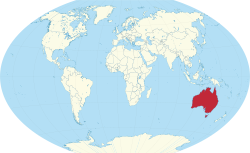Biology:Nymphaea vaporalis
| Nymphaea vaporalis | |
|---|---|
Script error: No such module "Conservation status".
| |
| Scientific classification | |
| Kingdom: | Plantae |
| Clade: | Tracheophytes |
| Clade: | Angiosperms |
| Order: | Nymphaeales |
| Family: | Nymphaeaceae |
| Genus: | Nymphaea |
| Species: | N. vaporalis
|
| Binomial name | |
| Nymphaea vaporalis S.W.L.Jacobs & Hellq.[1]
| |

| |
| Nymphaea vaporalis is endemic to Queensland, Australia[1] | |
Nymphaea vaporalis is a species of waterlily endemic to Queensland, Australia.[1]
Description
Vegetative characteristics
Nymphaea vaporalis is an annual or perennial species with globose rhizomes. The elliptic-suborbicular, 33 cm long, 28 cm wide leaves have an entire-sinuate margin.[2]
Generative characteristics
The fragrant, day-flowering, flowers can rise up to 30 cm above the water surface. The 12 cm long, 3.5 cm wide, sepals have an acute apex. The 22-25 cm long, 1.8-2.5 cm wide petals have an acute apex. The androecium consists of 200 yellow stamens with membranous, max. 2.3 cm long filaments. The anthers are 0.8 cm long, and have white appendages on the outer stamens. The gynoecium consists of 18 carpels. The ovary has vestigial sterile lobes. The 4 cm long, 3 cm wide, globose fruit carries glabrous, elongate, 2-2.6 mm long, and 1.5 mm wide seeds. The flowers smell like cinnamon.[2]
Reproduction
Generative reproduction
In Nymphaea vaporalis, a large percentage of seeds are aborted, but the fully developed seeds are viable.[2]
Taxonomy
Publication
It was first described by Surrey Wilfrid Laurance Jacobs and Carl Barre Hellquist in 2011.[1]
Type specimen
The type specimen of Nymphaea vaporalis was collected at an elevation of 287 meters above sea level by Jacobs and Hellquist in North Kennedy, Queensland on th 10th of June 2007.[2]
Placement within Nymphaea
It is placed in Nymphaea subgenus Confluentes.[2][3]
Hybridisation
Nymphaea vaporalis may be of hybrid origin.[2]
Etymology
The specific epithet vaporalis, meaning steam or smoke, is derived from the old steam engine water supply near Mingela, its only known habitat.[2]
Conservation
The NCA status of Nymphaea atrans is Special Least Concern.[4]
References
- ↑ 1.0 1.1 1.2 1.3 "Nymphaea vaporalis S.W.L.Jacobs & Hellq." (in en). Royal Botanic Gardens, Kew. http://www.plantsoftheworldonline.org/taxon/77111423-1. Retrieved 27 December 2023.
- ↑ 2.0 2.1 2.2 2.3 2.4 2.5 2.6 Jacobs, Surrey W. L.; Hellquist, C. Barre (2011). "New species, possible hybrids and intergrades in Australian Nymphaea (Nymphaeaceae) with a key to all species". Telopea 13 (1–2): 233–243. doi:10.7751/telopea20116016.
- ↑ Dalziell, E. L. (2016). "Seed biology and ex situ storage behaviour of Australian Nymphaea (water lilies): implications for conservation (Doctoral dissertation, PhD thesis." University of Western Australia, Perth, WA).
- ↑ Cite error: Invalid
<ref>tag; no text was provided for refs namedQueensland Government, 2022
Wikidata ☰ Q17253269 entry
 |

